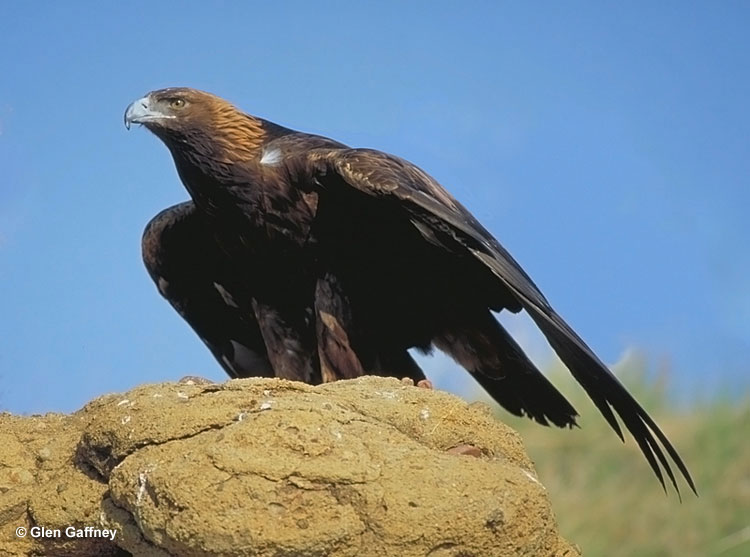The Golden Eagle is one of North America’s nimblest, largest, and fastest raptors. They got their name from the shiny gold feathers on the back of their head and neck. Their talons and beaks are powerful and show their hunting effectiveness.
These birds are common in the western portions of North America. They soar on steady wings and dive when in pursuit of prey like jackrabbits and other small mammals.
Golden Eagles show incredible bravery when defending their nest and their prey. They’ve been seen attacking large mammals, like coyotes and bears. Due to their courage, the Golden Eagle symbolizes both fear and reverence.
On this page
Breeding Male
Breeding male Golden Eagles have shiny golden feathers on the back of their neck and head. Additionally, they’re mostly brown over the rest of their body. They have long tails, relatively small heads, and broad, long wings.
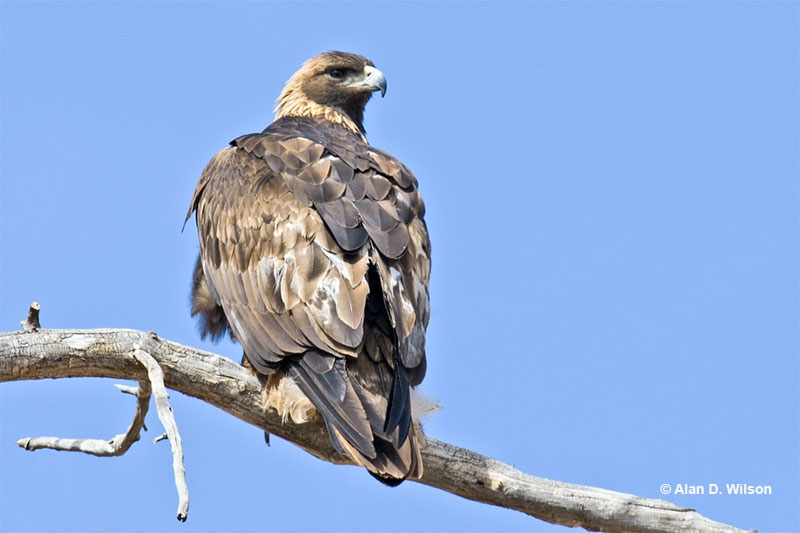
© Alan D. Wilson
They’re about the size of a goose, have a length of 27.6 to 33.1 inches (70 to 84 centimeters), and weigh 105.8 to 216.1 ounces (3000 to 6125 grams).
Female Golden Eagles look identical to male Golden Eagles.
Juvenile
Juvenile Golden Eagles have shiny golden feathers on the back of their neck and head. Additionally, they’re mostly brown over the rest of their body.
For the first several years of life, young birds will have well-defined white patches in the wings and at the base of the tail.
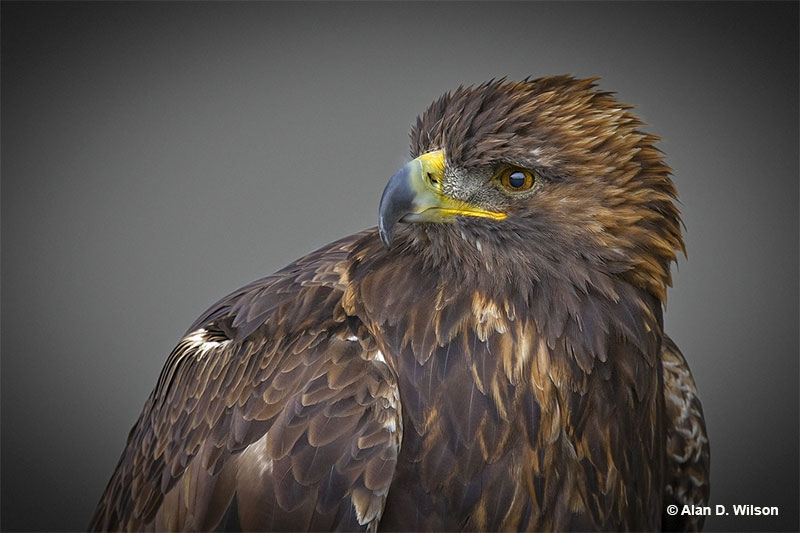
Habitat
Golden Eagles inhabit open and semiopen country across most of the Northern Hemisphere. These areas will have native vegetation as well. These birds avoid uninterrupted stretches of forest and developed areas.
They are mainly found in canyonlands, riverside bluffs and cliffs, rimrock terrain, and mountains up to 12,000 feet. They build their nests on vegetated areas like steep escarpments in grassland, cliffs, scrub, forest, and shrubland.
Diet
The Golden Eagle’s diet mainly consists of small and medium-sized mammals. Some of their prey include rabbits, hares, ground squirrels, marmots, and prairie dogs. In addition, they often consume black-tailed jackrabbits, and these mammals are a crucial prey species for this bird because they’re in much of their range.
Even though they mainly go after small and medium-sized mammals; Golden Eagles are more than capable of taking down larger mammals and birds, including swans, cranes, domestic livestock, and deer.
They have also been seen killing mountain goats, seals, bighorn sheep, coyotes, pronghorn, bobcats, and badgers. Golden Eagles prefer to feed on live prey, but when live prey is scarce, they feed on carrion.
Related: Falcon vs eagle
They let scavengers, like crows, find the carrion and then follow them to it. Additionally, Golden Eagles will rob nests, steal food from other birds, and catch fish.
Behavior
For their size, Golden Eagles possess incredible maneuverability and speed. They dive from significant heights and have been recorded hitting speeds close to 200 miles per hour!
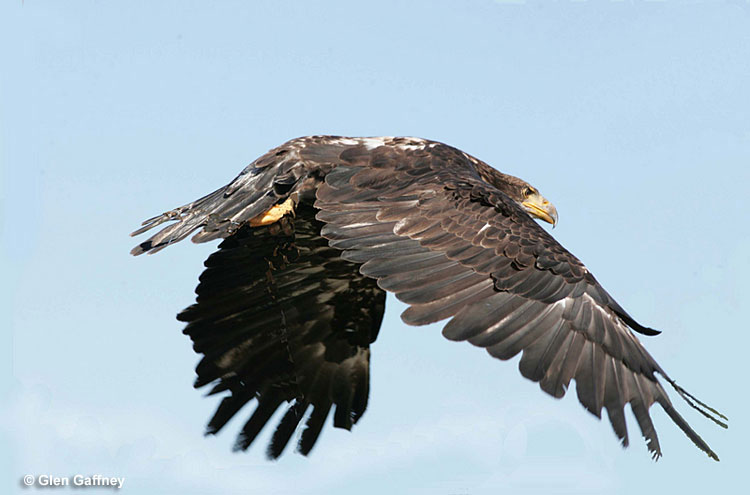
When courting a mate or marking their territory Golden Eagles will do a routine known as “sky-dancing.” This involves the birds performing a rapid series of up to 20 large upward swoops and dives. They’ll beat their wings 3 or 4 times at the top of each upward swoop.
Related: What is a group of eagles called?
Both pairs and single birds will participate in aerial play with objects like dead prey or sticks. They’ll carry the items high in the sky, drop them, and retrieve them.
Range (and seasonal changes)
Golden Eagles have a broad range. They can be found as far north as Alaska, all the way down to Mexico. These birds can also be found in the eastern portions of the United States but are not common.
Some Golden Eagles migrate, and some don’t. What determines if a Golden Eagle migrates or not is their geographic location.
They inhabit a large portion of Eurasia as well, and are even present in some parts of Africa.
Wing shape
Golden Eagles have long, broad, rectangular wings. When in flight, the underparts of their wings are all dar; they have no white wing patches. Additionally, they have a wingspan of 72.8 to 86.6 inches (185 to 220 centimeters).
Related: Golden Eagle vs Bald Eagle
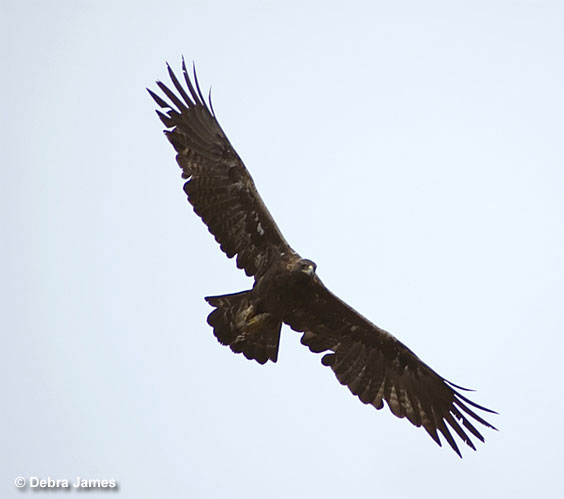
Fun Facts
- The Golden Eagle is the most prevalent official national animal across the globe. This bird is the emblem of Germany, Albania, Austria, Kazakhstan, and Mexico.
- Both Golden and Bald Eagles, as well as their feathers, are considered sacred and greatly respected within American Indian culture, religion, and tradition. They represent truth, strength, majesty, courage, freedom, power, and wisdom.
- There are only 3 American raptors that have legs that are feathered all the way to their toes. Those raptors are the Golden Eagle, Rough-legged Hawk, and Ferruginous Hawk.
- Government officials, engineers, and Biologists have worked together to create and utilize power poles to lessen raptor electrocutions. Unfortunately, it’s not uncommon for raptors to get electrocuted when perching or flying near powerlines. When large birds’ wings or feet accidentally touch two lines at the same time, it creates a circuit causing electrocution.
- Golden Eagles are the largest Eagles living in North America. Did you know that the title of the largest eagle in the world belongs to the Philippine Eagle?
Vocalization
Golden Eagles don’t vocalize very often. When they do talk, their calls tend to be weak, whistled, and high-pitched.
Golden Eagles are the most vocal during their breeding season, when adults announce their approach with food with a wonk or a wip and when nestlings’ high-pitched calls can travel over a mile.
Similar Species
Golden Eagles can be confused with some other species, here are the most common options:
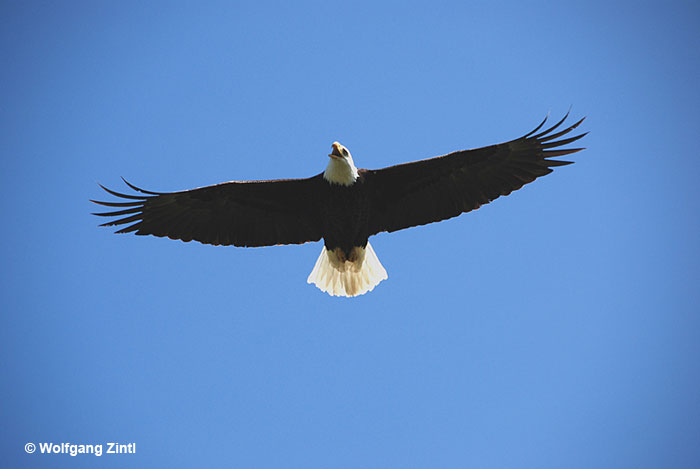
Bald Eagle
Golden Eagles and Bald Eagles are roughly the same size, but Bald Eagles are generally a bit bigger.
Golden Eagles have brownish plumage everywhere, but as we all know, Bald Eagles are known for their signature white heads.
The underside of their tail is also whitish, making them easier to identify when you see one soaring above you.
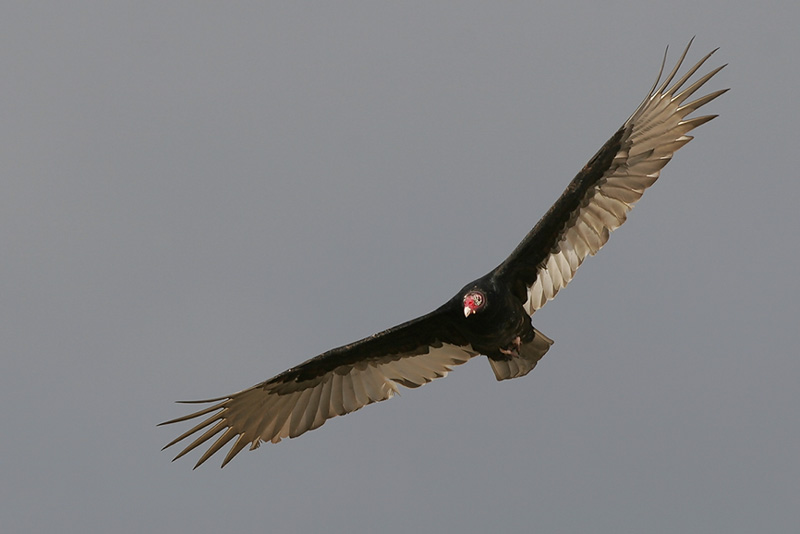
Turkey Vulture
Compared to Golden Eagles, Turkey Vultures can be a bit smaller and their wingspan is quite a bit smaller.
Their plumages look similar, but Turkey Vultures have a bald pinkish-red heads.
The underside of their wings is a bit lighter, almost completely white, and their tails are not as flared as Golden Eagles.
Frequently Asked Questions
How rare is it to see a Golden Eagle?
It’s pretty rare to see a Golden Eagle because these birds are not common! However, you have the best chance of seeing one in the western half of the United States, Alaska, or Canada.
What is special about Golden Eagles?
Golden eagles have several unique features: the namesake “golden” nap on the neck, the feathered feet, and the impressive size and wingspan.
Due to their majestic appearance, they have also deserved a prominent place in human cultures across their range.
What does a Golden Eagle look like?
Golden eagle is a large raptor with plumage color consisting of different brown hues. The defining golden brown appears around the neck.
The bird’s profile seems relatively short-necked when compared to other raptors. The beak is large and powerful, and the upper portion of the feet is distinctly feathered, creating an image of the eagle having feathered “boots.”
Where do Golden Eagles live?
Golden eagles are found in the grasslands of the entire Northern Hemisphere. Because they’re such large birds, the vast open habitat allows them to hunt prey with greater efficiency.

